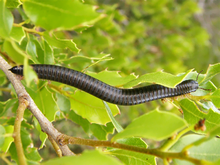MILLIPEDES

Portuguese Millipede
From: https://en.wikipedia.org/wiki/Ommatoiulus_moreleti
From: https://en.wikipedia.org/wiki/Ommatoiulus_moreleti
WESTERN COVE PLAGUED
When the Portuguese millipedes plague came to Western Cove it soon became clear that controlling them by squashing them was not an option.
On days of repeated rainfall they marched toward my house in huge numbers. At night walking outside became a crunchy experience.
Squashing produces a yellow unpleasant-smelling fluid which can irritate the eyes and leave permanent stains. Householders elsewhere have employed chemical and physical barriers. My method was to sweep them up near the house every hour or two and drown them in buckets of water. While not a complete answer this kept the numbers down somewhat.
I've forgotten in which year these millipedes appeared — as a guess, 2009.
A year or two later a natural control factor must have come into effect since their numbers were much reduced and got lower after that.
Before their sudden appearance at Western Cove I had never noticed them anywhere.
O. MORELETI
The Portuguese millipede, Ommatoiulus moreleti, is a herbivorous millipede which eats leaf litter and decaying wood.
International shipping transferred it from Portugal/Spain to other countries. In 1953 it arrived at Port Lincoln and spread across Australia where it had no natural enemies.
Millipedes are not worms but arthropods with an exoskeleton, a segmented body, and two pairs of legs attached to each segment underneath the body. This is the major difference with centipedes which have only one pair of legs per segment and attached to the sides of the body. Another main difference is that centipedes are carnivores with venomous fangs which can inflict painful wounds. Centipedes also have flatter bodies, longer, threadlike antennae, and can dash around at speed whereas millipede motion is more leisurely.
Portuguese millipedes can be almost unnoticed in summer but become very active after rainfall in autumn when they also mate.
Mature females each lay over 100 eggs beneath the soil where they begin their three-year life span. Although "milli" means 1000 no millipede species has that many legs. O. moreleti hatchlings have only three pairs of legs which increase to over 100 on 50 segments on individuals that live long enough. Like other millipedes O. moreleti feed on dead plant matter, break it down, and recycle nutrients back to the soil. When touched or otherwise threatened they curl into a circle, but they don't bite and in that sense are harmless.
In parts of South Australia Portuguese millipedes reached plague densities in the 1970s and sometimes caused slippage of locomotives on railway lines! In urban areas O. moreleti entered houses during autumn, winter and spring. They are most active after rain but also at night (when they are attracted by house lights).
The numbers plummeted in the 1980s due to parasitism by a nematode (Rhabditis necromena) that transferred to them from native species of millipedes.
When planet Earth was young there were millipede-like creatures that grew 2 metres long and half a metre thick. The Portuguese millipedes at Western Cove fortunately rarely grew longer than 6 centimetres.
Approximately 12,000 millipede species have been describe, divided into two subclasses, 16 orders, and 140 families.
Classification of Portuguese Millipedes:
| Kingdom: | Animalia
|
| Phylum: | Arthropoda
|
| Subphylum: | Myriapoda
|
| Class: | Diplopoda
|
| Order: | Julida
|
| Family: | Julidae
|
| Genus: | Ommatoiulus
|
| Species: | O. moreleti
|
ANOTHER SPECIES
The millipedes in the following photo are probably a different species than O. moreleti because they are not as smooth or as dark-colored and are also thicker (or fatter) and slower in movement.

Two separate entangled bunches of them, four metres apart, appeared in my back yard on the morning of May 9th, 2017. An hour later they were still entangled and had moved about a metre.
A return visit in late afternoon to where they were last seen in the morning failed to find them.
Websites for further information:
https://en.wikipedia.org/wiki/Millipede.htm
https://en.wikipedia.org/wiki/Ommatoiulus_moreleti
https://www.abc.net.au/news/2017-03-22/masses-of-millipedes-march-across-southern-australia/8376004
https://www.terminix.com/blog/bug-facts/interesting-facts-about-millipedes/
https://www.environment.gov.au/system/files/pages/d5a53ba2-2d7a-428c-8531-6f000ae2b9c4/files/species-sa-kangaroo-island
Grains, Research & Development Corporation, Black Millipedes & Slaters Fact Sheet, October 2013
https://grdc.com.au/__data/assets/pdf_file/0028/159319/final-hr-grdc-millipedes-slaters-fact-sheet-pdf.pdf